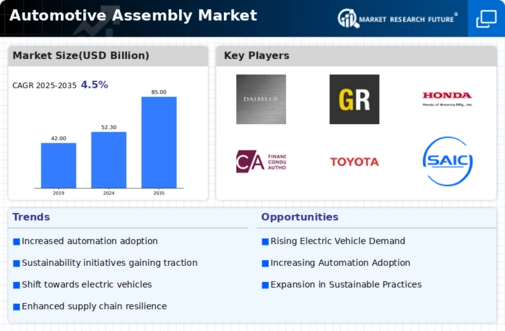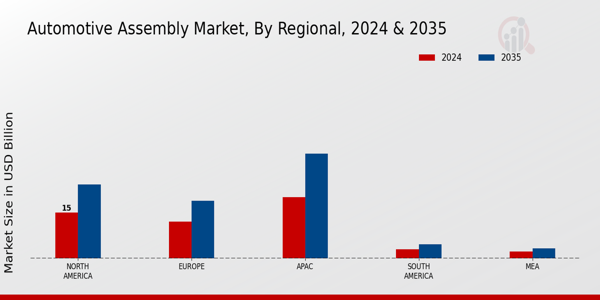Market Growth Projections
Global Supply Chain Optimization
The optimization of global supply chains is a significant driver of the Global Automotive Assembly Market Industry. As manufacturers seek to enhance efficiency and reduce costs, they are increasingly focusing on streamlining their supply chains. This involves the integration of advanced logistics solutions and real-time data analytics to improve inventory management and reduce lead times. The ongoing efforts to create more resilient supply chains are expected to bolster the market, particularly as companies adapt to fluctuating demand and geopolitical challenges. By enhancing supply chain efficiency, manufacturers can better respond to market dynamics, ultimately supporting the projected growth of the industry.
Rising Demand for Electric Vehicles
The Global Automotive Assembly Market Industry experiences a notable shift towards electric vehicles (EVs), driven by increasing consumer awareness of environmental issues and government incentives for sustainable transportation. In 2024, the market is projected to reach 52.3 USD Billion, reflecting a growing preference for EVs over traditional combustion engines. This transition necessitates new assembly techniques and technologies, as manufacturers adapt to the unique requirements of EV production. The anticipated growth in EV sales is expected to significantly influence the overall automotive assembly landscape, with projections indicating that by 2035, the market could expand to 85 USD Billion, showcasing the industry's commitment to sustainability.
Government Regulations and Standards
Government regulations and standards significantly influence the Global Automotive Assembly Market Industry. Stricter emissions regulations and safety standards compel manufacturers to innovate and invest in cleaner technologies and safer vehicles. Compliance with these regulations often requires substantial changes in assembly processes and materials used in production. As governments worldwide implement more stringent policies, the industry must adapt to maintain compliance while meeting consumer expectations for performance and sustainability. This regulatory environment is likely to drive investment in new technologies and processes, further shaping the future of automotive assembly.
Consumer Preferences for Customization
The Global Automotive Assembly Market Industry is increasingly influenced by consumer preferences for vehicle customization. As consumers seek personalized features and designs, manufacturers are compelled to adapt their assembly processes to accommodate these demands. This trend towards customization not only enhances customer satisfaction but also drives innovation in assembly techniques. The ability to offer tailored options can differentiate brands in a competitive market, potentially leading to increased sales. As the industry evolves, the focus on customization is expected to play a pivotal role in shaping assembly strategies and production capabilities.
Technological Advancements in Manufacturing
Technological innovations play a crucial role in shaping the Global Automotive Assembly Market Industry. Automation, robotics, and artificial intelligence are increasingly integrated into assembly lines, enhancing efficiency and precision. These advancements not only reduce production costs but also improve product quality, which is vital in a competitive market. As manufacturers adopt smart manufacturing practices, the industry is likely to witness a compound annual growth rate (CAGR) of 4.51% from 2025 to 2035. This growth is indicative of the industry's response to the need for faster production cycles and the ability to customize vehicles according to consumer preferences.


























